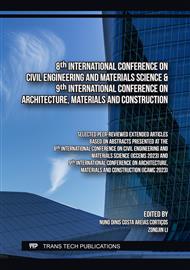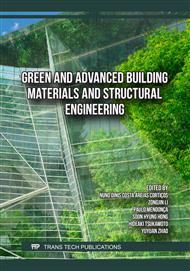[1]
N. Yaseen, M. Irfan-ul-Hassan, A.U.R. Saeed, S.A. Rizwan, and M. Afzal, Sustainable development and performance assessment of clay-based geopolymer bricks incorporating fly ash and sugarcane bagasse ash. J. Mater Civil Engineering, 34(4) (2022), p.04022036.
DOI: 10.1061/(asce)mt.1943-5533.0004159
Google Scholar
[2]
N. Dalkılıç, and A. Nabikoğlu, Traditional manufacturing of clay brick used in the historical buildings of Diyarbakir (Turkey). Frontiers of Architectural Research, 6(3) (2017), pp.346-359.
DOI: 10.1016/j.foar.2017.06.003
Google Scholar
[3]
M. Dabaieh, J. Heinonen, D. El-Mahdy, and D.M. Hassan, A comparative study of life cycle carbon emissions and embodied energy between sun-dried bricks and fired clay bricks. J. Cleaner. Prod, 275 (2020), p.122998.
DOI: 10.1016/j.jclepro.2020.122998
Google Scholar
[4]
B.S. Thomas, and R.C. Gupta, A comprehensive review on the applications of waste tire rubber in cement concrete. Renewable and Sustainable Energy Reviews, 54 (2016), pp.1323-1333.
DOI: 10.1016/j.rser.2015.10.092
Google Scholar
[5]
A.O. Adeboje, W.K. Kupolati, E.R. Sadiku, J.M. Ndambuki, and C. Kambole, Experimental investigation of modified bentonite clay-crumb rubber concrete. Construct. Build. Mater, 233 (2020), p.117187.
DOI: 10.1016/j.conbuildmat.2019.117187
Google Scholar
[6]
F. Zakaria, M.A. Radwan, M. Sadek, and H.A. Elazab, Insulating material based on shredded used tires and inexpensive polymers for different roofs. International J. Engineering and Tech, 7(4) (2018), pp.1983-1988.
DOI: 10.14419/ijet.v7i4.14081
Google Scholar
[7]
B. Herbudiman, and A.M. Saptaji, Self-compacting concrete with recycled traditional roof tile powder. Procedia Engineering, 54 (2013), pp.805-816.
DOI: 10.1016/j.proeng.2013.03.074
Google Scholar
[8]
K. Muhamad, N.Z. Zainol, N. Yahya, S.N.A.M. Noor, N.H. Hashim, and D.Z. Shahrazi, Influence of rice husk ash (RHA) on performance of green concrete roof tile in application of green building. In IOP Conference Series: Earth and Environmental Sci. Vol. 476, (2020) p.012038.
DOI: 10.1088/1755-1315/476/1/012038
Google Scholar
[9]
M.S. Sultana, A.N. Ahmed, M.N. Zaman, M.A. Rahman, P.K. Biswas, and P.K. Nandy, Utilization of hard rock dust with red clay to produce roof tiles. J. Asian Ceramic Societies, 3(1) (2015), pp.22-26.
DOI: 10.1016/j.jascer.2014.10.005
Google Scholar
[10]
A.K. Krishnan, Y.C. Wong, Z. Zhang, and A. Arulrajah, Recycling of glass fines and plastics in clay bricks at low temperatures. In Proceedings of the Institution of Civil Engineers-Waste and Resource Management (2022), pp.1-9.
DOI: 10.1680/jwarm.22.00014
Google Scholar
[11]
C. Zanelli, D. Girolamo, C. Sonia, M. Chiara, and D. Michele, Improving the frost resistance of roof tiles beyond current prediction schemes. Open Ceramics, 10 (2022), p.100249.
DOI: 10.1016/j.oceram.2022.100249
Google Scholar
[12]
P. Su, Q. Dai, M. Li, Y. Ma, and J. Wang, Investigation of the mechanical and shrinkage properties of plastic-rubber compound modified cement mortar with recycled tire steel fiber. Construct. Build. Mater, 334 (2022), p.127391.
DOI: 10.1016/j.conbuildmat.2022.127391
Google Scholar
[13]
ASTM C1167/2011, "Standard Specifications for clay roof tiles" (2017).
Google Scholar
[14]
P.B. Lourenço, F.M. Fernandes, and F. Castro, Handmade clay bricks: chemical, physical and mechanical properties. International J. Architectural Heritage, 4(1) (2010), pp.38-58.
DOI: 10.1080/15583050902871092
Google Scholar
[15]
P. Turgut, P. and B. Yesilata, Physico-mechanical and thermal performances of newly developed rubber-added bricks. Energy and Build, 40(5) (2008), pp.679-688.
DOI: 10.1016/j.enbuild.2007.05.002
Google Scholar



